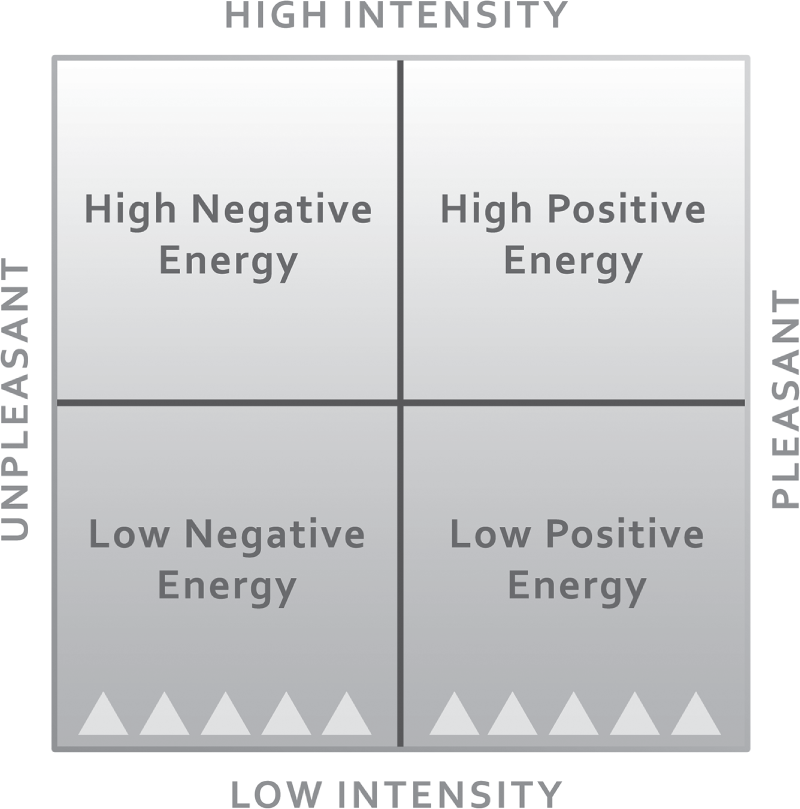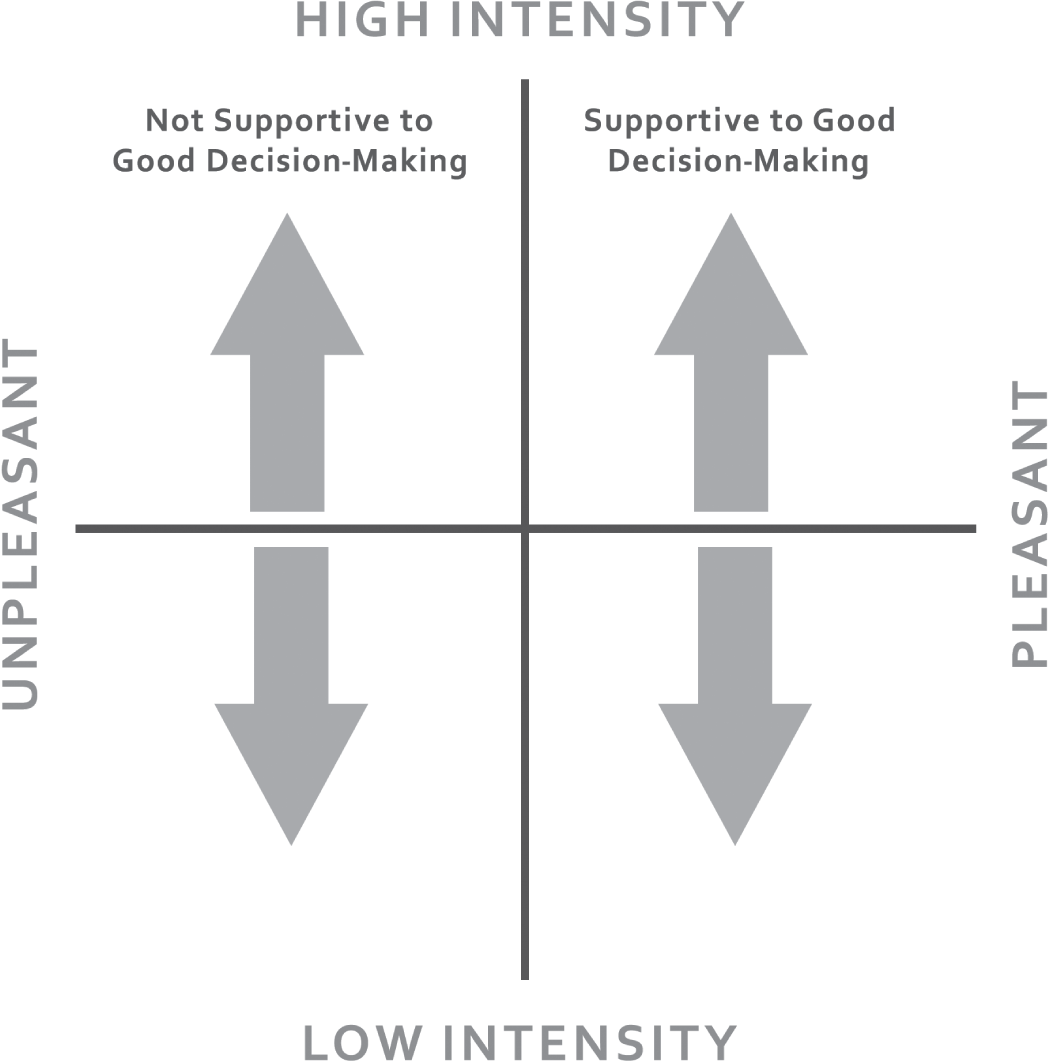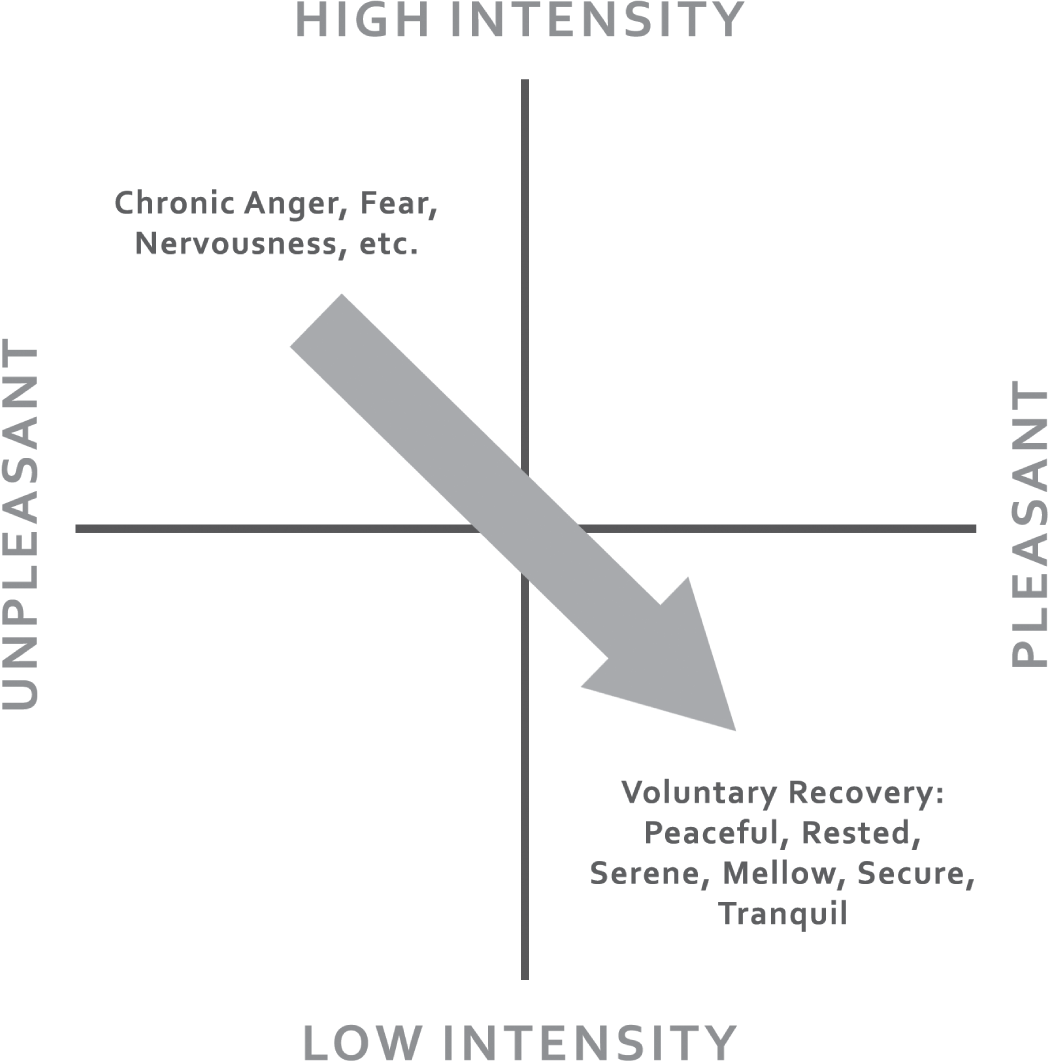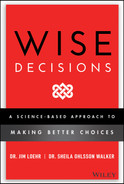Chapter 11
Managing Energy and Your Inner Voice
Energy, not time, is your most precious resource. Success in life will not be measured by the number of years you lived, but rather by the energy you brought to the time you had, aligned with what mattered most to you while we were here.
Energy infuses life into time, and the union of energy and time is what makes everything happen in life. Every one of the 30 trillion cells in the human body has its own energy production plant called the mitochondria, and cellular energy production is what ignites life in the human system. And human energy, like all energy in the universe, possesses quantity, quality, focus, and intensity (force). Here's the critical insight:
Energy investment spawns life, and one's inner voice controls energy investment.
Let's start with these energy fundamentals. Making a conscious effort to do something means intentionally investing your energy in that activity. Making a conscious effort to strengthen your biceps by lifting weights is an example. The critical ingredient in the growth‐stimulating process is energy investment. Spending time in the gym but failing to invest targeted energy into building your bicep will not get the job done. This same principle is true with everything, such as investing your energy in being a good parent, improving your backhand in tennis, or growing your capacity for kindness or gratefulness. And the greater the quantity, quality, focus, and intensity of the energy invested, the greater the chance that growth will be spawned.
Intentionally investing one's full and best energy is called full engagement and represents the real sweet spot of human energy. To be fully engaged means you're all in, investing the greatest quantity, highest quality, most precise focus, and greatest intensity of energy, right here, right now. Showing up fully engaged is the greatest gift we have to give to the world because of its direct connection to expanded growth. In other words, when we take energy (life) from our body and invest it elsewhere, we give life and the potential for growth to whomever or whatever we've chosen to give our energy. The central connection of all this to managing your energy and strengthening your Y.O.D.A., is that your inner voice is the master controller of all your energy investments. Your private inner voice ultimately determines who or what you will give life energy to, and the quantity, quality, focus, and intensity of the energy invested.
Two Important Dimensions of Energy
Examining energy through a two‐dimensional lens provides important insights in managing energy relative to sound decision‐making. The two dimensions are energy intensity and energy valence. Energy intensity, sometimes referred to as force, can range from low intensity to high intensity, and energy valence refers to whether the energy is positive or negative. Another way to think about energy valence is whether the energy feeling state is perceived as pleasant or unpleasant. The two‐dimensional model creates four cells (see Figure 11.1):
- High Positive
- Low Positive
- High Negative
- Low Negative
Common feelings associated with each of the four energy cells are shown in Figure 11.2.
Reflect for a moment on the decisions you have made when you were in a high negative energy state, when you are angry, anxious, resentful, or afraid. How about low negative energy? Were you able to make good, sound decisions when you were depressed, exhausted, feeling burned out, hopeless, or unmotivated? Most report that a state of high or low negative energy can seriously compromise their decision‐making process. Most also report that wise, timeless decisions are best made in either high positive or low positive energy cells.

Figure 11.1 The four cells of energy dimensions.

Figure 11.2 The feelings connected to each energy cell.
This is precisely where reflective consciousness becomes critical. Acknowledging which energy cell you're in prior to making important decisions is essential information for Y.O.D.A. to consider in the deliberation process.
The takeaway here is this: Except in cases of immediate threats to your survival, postpone, delay, or change your negative energy state before making important decisions. (See Figure 11.3.)

Figure 11.3 Understanding the negative energy state.
Some Additional Wise Decision Insights to Consider
High negative energy states are essentially survival based and consume high levels of our energy reserves. Intense anger, fear, resentment, and the like can produce high levels of adrenocortical hormones such as cortisol, epinephrine, and norepinephrine, which not only can compromise our judgment and decision‐making, but can be very harmful to our overall health over time.
The point here is not to demonize negative energy states. There is an appropriate time and place for all emotions and their outward‐facing counterpart of our feelings, as long as we can understand the messages being sent and then move forward to constructively adapt to whatever challenges we face. Chronic exposure to high negative energy states will eventually drain our energy reserves, leading to low negative energy for survival purposes. Low energy states like exhaustion, hopelessness, depression, or feeling burned out often represent the body's effort to protect you by forcing you into a badly needed recovery mode.
Figure 11.4 depicts the tendency for chronic high negative energy states to unknowingly move you toward low energy. This represents a survival strategy by the body to restore strength in order to prevent long‐term damage.
A healthier and more adaptive alternative is to break chronic negative energy states with voluntary recovery. (See Figure 11.5.)
Low positive energy is the quadrant in the energy figure that holds healing and recovery. This represents energy restoration and renewal. It is the quadrant of mind‐body regeneration. Music, meditation, breathwork, tai chi, nature walks, massage, prayer, quality time with loved ones, sports participation, and creative painting are just a few of the ways one can voluntarily seek recovery.
Wise Decision Insight: Get to the positive side of your energy valence before making important life decisions. Use voluntary recovery to get the energy balance right before making big choices. Energy is a result of self‐care and good health, and as you recall from Chapter 1, it is our health that ignites our wisdom in decision‐making.

Figure 11.4 Movement from high to low intensity.
Y.O.D.A. Energy Management Basics
- The amount of energy that can be stored in the human body is limited, and we therefore must be very discriminating and purposeful in our energy investments. Y.O.D.A. must constantly advise our inner voice on when and where energy investments should be made in alignment with our highest priorities in life.
- The healthier you are physically, emotionally, mentally, and spiritually, the more energy is typically available for investment, hence the better your decisions. Because cellular energy production occurs fundamentally in the union of oxygen and glucose, issues of nutritional input and aerobic as well as anaerobic fitness are particularly important in both health and sound choices.

Figure 11.5 Voluntary recovery assists in disrupting negative energy.
- You are the sum total of your energy investments thus far in your life, whether they are intentional or not. Follow your energy! If you have given abundant energy to impatience, sarcasm, victimhood, or cynicism, that's precisely what you've gotten back. Investments in hope, courage, reality‐based thinking, honesty, or compassion will spawn vastly different areas of growth. Investments in strengthening your decision‐making skills will pay dividends for a lifetime.
- Our ancestors had to develop a conservation of energy bias to ensure survival when food and shelter were scarce. Energy investment was restricted to only those activities that increased their chances for survival. That same conservation bias continues today, regardless of whether food, water, or shelter are abundantly available. A transcendent life purpose, a purpose beyond one's self‐interest, and enduring core values open the carefully guarded vault to our energy reserves. When Y.O.D.A. is preloaded with critical operating instructions regarding purpose and values, it can provide judicious and discerning energy investment decisions.
- Human beings are complex, multidimensional energy systems, and the ordering principle for the entire energy system is purpose. Our enduring life purpose can work to order and prioritize our energy investments throughout life. The senior officer in charge of investments is our inner voice.
- Training Y.O.D.A. to move from time literacy to energy literacy, from time awareness to energy awareness, from managing time to managing energy, represents a quantum leap in expanding perspective and wisdom in decision‐making.
- Life begins with energy's first pulse and ends with its last. Nothing happens until energy causes something to move. If we want something to weaken or die, we must cut off its energy supply; we simply must not go there with our energy. Atrophy or death is the consequence of cutting off the energy supply to our brain and body. With great counsel, we can make wise and thoughtful energy decisions about what to strengthen and grow and what we intentionally allow to atrophy and die.
- High negative and low negative energy states can completely compromise our capacity for making sound judgments and wise decisions. Every effort should be made to delay decision‐making until we can access states of high positive or low positive energy.
Sources
- Csikszentmihalyi, M. “The Flow Experience.” In D. Goleman and R. Davidson (Eds.), Consciousness: Brain, States of Awareness and Mysticism. New York: Harper & Row, 1979.
- Loehr, J. E. Athletic Excellence. Denver: Forum, 1982.
- Loehr, J. E. “The Ideal Performance State.” Sports Science Periodical on Research and Technology in Sport. Addison‐Wesley; January 1983.
- Loehr, J. E. Mental Toughness Training for Sports. New York: Penguin, 1982.
- Loehr, J. E., and J. Groppel. The Corporate Athlete Advantage. Orlando: Human Performance Institute, 2008.
- Loehr, J. E., and T. Schwartz. “Making of a Corporate Athlete.” Harvard Business Review, 2001.
- Loehr, J. E., and T. Schwartz. The Power of Full Engagement. New York: Simon & Schuster, 2003.
- Murphy, M., and R. White. The Psychic Side of Sports. Boston: Addison‐Wesley, 1978.
- Tohei, K. Ki in Daily Life. Tokyo: Ki No Kenkyukai H.O., 1980.
